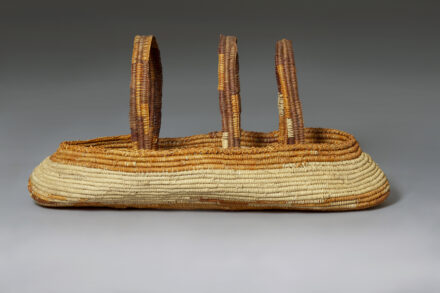
Article by Dr Duncan Wright
Senior Lecturer in Archaeology,
School of Archaeology and Anthropology, ANU
&
Professor Mike Smith
Senior Research Fellow – Archaeology (emeritus),
Research Centre, National Museum of Australia
This grinding stone was collected by Don Burton in 1972 in the Atherton Tableland region, Queensland. In 1975, a grindstone was excavated at Botobolar 5, a rock shelter located to the northeast of Mudgee in New South Wales (Pearson 1981, pp. 129-130). It was recovered alongside eighty whole Macrozamia nuts or kernels, including seven burnt nuts, twelve burnt kernels and large quantities of husk consistent with grinding. Seed cones (one containing articulated seeds) were recovered, as well as a layer containing connective pieces from within these cones. Macrozamia were associated with a hearth feature dated to 466-125 before present (at 86% probability; calib 8.02) at a site that preserved evidence for cultural activity dating back to 6741-6308 years ago (at 95.4% probability). Macrozamia secunda, a species identified at this site, reaches maturity in March, suggesting that this site may have been most often utilised during late summer and early autumn.

This grindstone allows us to time-travel, exploring innovations occurring many centuries ago. Macrozamia, when not treated correctly can be toxic. Early Dutch, French and English accounts describe members of Vlamingh, La Perouse, Flinders and Sir George Grey expeditions incapacitated by eating cycad seeds and nuts (e.g., Macintyre & Dobson 2018). One Dutch officer described in his diary (sixth January 1697) that, upon eating these seeds, he and five crew members “began to vomit so violently that there was hardly any difference between us and death” with symptoms resembling “madness” lasting for two days (cited in Roberts 1972, p. 23). It is equally clear that First Nation communities (and some nineteenth century European arrivals) were adept at collecting parts of these plants during particular seasons, in which toxins were significantly reduced (e.g., Macintyre & Dobson 2018). Some First Nation communities also demonstrated remarkable methods of processing the fleshy outer part of these cycads to make them edible. The Noongar people, for example, steeped by-yu or baio cycads in water or buried them until the nut “reached a state approaching decay” (Moore fourteenth April 1835 in Shoobert 2005, pp. 424; see also Grey 1841, p. 297). It was then possible to pound these into a flour or roast the seeds on hot coals.
Archaeological research in Eastern Australia reveals use of Macrozamia nuts from at least 5000 years ago. This was followed by a substantial increase, after 2000 years ago, at which point there was a similar proliferation in seed grinding economies and related equipment (Asmussen & McInnes 2013, p. 476; Smith 2013). This increase was possibly a response to higher populations during the last few millennia, which led to more intensive exploitation of plant foods within local foraging estates. Botobolar and similar sites (e.g., Capertee 3, Noola, Kenniff Caves and Bomaderry) fit with this later phase (see Asmussen & McInnes 2013 for a review). In Western Australia, however, there is a longer history of cycad use. Excavations at Cheetup Rockshelter in the Esperance region revealed a pit feature “sealed by a layer dating to c. 13,200 BP” (Smith 1982, p. 120), a minimum age of 14,946 years ago (at 95.4% probability when calibrated). Inside the pit were Macrozamia kernels and Xanthorrhoea leaf bases, possibly indicating water-leaching and fermenting. At Cathedral, Rainbow and Wanderers Caves in Carnarvon Gorge (Queensland), large quantities of burnt Macrozamia moreii seeds were found in deposits post-dating 4500 years ago (Beaton 1991). In short, our object when interpreted within a broader archaeological context, provides a crucial piece in the puzzle about Australia’s long and vibrant history.
References
Asmussen, B & McInnes, P 2013, ‘Assessing the impact of mid-to-late Holocene ENSO-driven climate change on toxic Macrozamia seed use: a 5000 year record from eastern Australia’, Journal of Archaeological Science, vol. 40, pp. 471-480.
Beaton, JM 1991, ‘Cathedral Cave: a rockshelter in Carnarvon Gorge, Queensland’, Queensland Archaeological Research, vol. 8, pp. 33-84.
Grey, G 1841, Journals of Two Expeditions of Discovery in North-West Australia, T and W Boone, London.
Macintyre, K & Dobson, B 2018, ‘The ancient practice of Macrozamia pit processing in southwestern Australia’, Anthropology from the shed, vol. March 2018.
Pearson, M 1981, ‘Seen through different eyes: changing land use and settlement patterns in the Upper Macquarie River Region of NSW, from prehistoric times to 1860’, PhD thesis, Australian National University, Canberra.
Robert, WCH 1972, The Explorations, 1696-1697, of Australia by Willem de Vlamingh, Philio Press, Amsterdam.
Shoobert J (ed) 2005, Western Australian Exploration 1826-1835, The Letters, Reports & Journals of Exploration and Discovery in Western Australia, vol. 1, Heperian Press, Victoria Park.
Smith, M 1982, ‘Late Pleistocene zamia exploitation in southern Western Australia’, Archaeology in Oceania, vol. 17, pp. 117-121.
Smith, M 1996, ‘Revisiting Pleistocene macrozamia’, Australian Archaeology, vol. 42, pp. 52-53. Smith, MA 2013, The Archaeology of Australia’s Deserts, Cambridge University Press, Cambridge.



